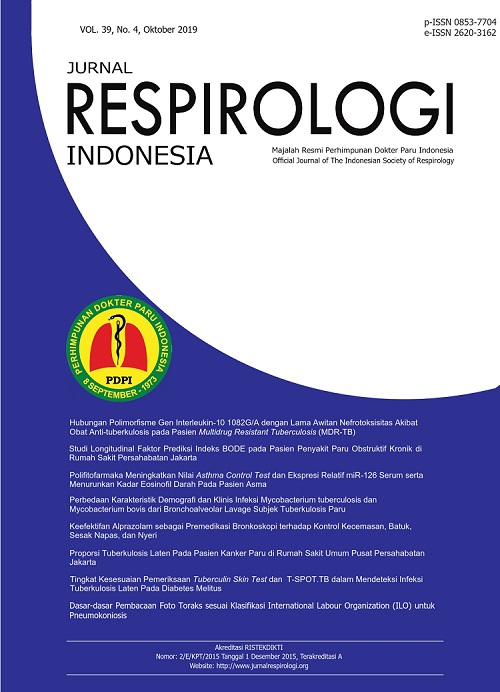Longitudinal Study Of BODE Index As Predictive Factor of COPD In Persahabatan Hospital Jakarta
DOI:
https://doi.org/10.36497/jri.v39i4.75Keywords:
Exacerbation, BODE index, HRQoLAbstract
Background: The BODE index is generally used for predicting mortality risk of COPD patients. The BODE index included the body mass index, degree of airflow obstruction (FEV1), dyspnea (MMRC questionnaire), and exercise capacity (6-minute walk test). Exacerbation of COPD associated with decreased health related quality of life (HRQoL). HRQoL has become an important outcome in respiratory patients as proved by St.George’s Respiratory Questionnaire (SGRQ). This study aim to find the correlation between BODE index with exacerbation and quality of life of COPD patients. We hypothesized that the higher BODE index score, the more frequent exacerbation occurrence and HRQoL decreased. Methods: Prospective cohort study of COPD patients was conducted in Persahabatan Hospital in November 2010 till June 2011. This study assessed the BODE index (at baseline) and followed at 3, 6, 9 and 12 months. Patient were also examined with SGRQ at baseline and followed at 6 and 12 months. We monitored the occurrence of exacerbation every month by telephone, observed their medical record, or visited the COPD’s clinic and emergency departement. Results: Eighty-five patients were examined at baseline with mean of BODE index 4.29 and SGRQ total score 41.42%. After one year follow up 52 patients have completed examination, 29 patients have not complete examination and 4 patients died. Using t-test analysis the correlation of BODE index between single and frequent exacerbation was significant (P<0.05), the correlation of SGRQ between single and frequent exacerbation was also significant (P<0.05) and correlation between BODE and SGRQ was significant (P=0.045). Conclusion: BODE index can predict COPD exacerbations and HRQoL. (J Respir Indo. 2019; 39(4): 220-30)Downloads
References
Casanova C, Torres JP, Armando AJ, Victor PP, Jose MM, Cordoba E, Baz R, Cote CG. The progression of chronic obstructive pulmonary disease is heterogeneous the experience of the BODE cohort. AJRCCM. 2011;184:1014-22.
Global Initiative for Chronic Obstructive Lung Disease (GOLD). Pocket guide to COPD diagnosis, management and prevention. Genewa: WHO; 2011.p.1-8.
Barnes PJ, Celli BR. Review systemic manifestation and comorbidities of COPD. Eur Respir J. 2009;33:1165-85.
Ong K, Ernest A , Suat J. A multidimensional grading system (BODE index) as predictor of hospitalization for COPD. Chest. 2005;128:3810- 16.
Cote CG, Dordelly LJ, Celli BR. Impact of COPD exacerbations on patient-centered outcomes. Chest. 2007;131:696-704.
Sudigdo S, Sofyan I. Dasar-dasar metodologi penelitian klinis, edisi 3. Jakarta: Sagung Seto; 2008.p.310-13.
Abidin. Manfaat rehabilitasi paru dalam meningkatkan atau mempertahankan kapasiti fungsional dan kualiti hidup penderita penyekit paru obstruktif kronik di rumah sakit persahabatan. Tesis Departemen Pulmonologi dan Kedokteran Respirasi FKUI. Jakarta; 2008.
Ngungtjik. Efikasi pemberian kombinasi inhalasi salmoterol dan flutikason propionate melalui alat diskus pada penyakit paru obstruktif kronik. Tesis Departemen Pulmonologi dan Kedokteran Respirasi FKUI. Jakarta; 2009.
Anzueto A. Review impact of exacerbations on COPD. Eur Respir Rev. 2010;19:113–18.
Celli BR, Cote CG, Marin JM, Cassanova C, Oca MM, Mendez RA. The body mass index, airflow obstruction, dyspneu, and exercise capacity index in chronic obstructisve pulmonary disease. N Engl J Med. 2004;350:1005-12.
Fanny WS, Wilson TB, Alvin HM, Tung A, Jenny N, Susanna SS, Kenneth L, Ka FA, David SC. A longitudinal study of serial BODE indices in predicting mortality and readmissions for COPD. Respiratory Medicine. 2011;105:266-73.
Robert A. Chronic obsructive pulmonary disease: Clinical course and management. In: Fishman, editors. Pulmonary diseases and disorders. 4 th edition. Philadelphia: MCGraw-Hil; 2007.p.731-33.
Donaldson G, Terence A, Seemungal, Patel S, Jadwiga A, Tom B. Airway and systemic inflamation and decline in lung function in patient with COPD. Chest.2005;128:1995-96.
Miravitlles M, Ferrer M, Pont A. Effect of exacerbations on quality of life in patients with COPD: A 2 year follow up study. Thorax. 2004;59:387–95.
Amoros MM, Tous CM, Sottora FR, Ponsceti RM, Flores MJ, Dolz MT. Health related quality of life is associated with COPD severity: A comparison. Health Qual Life Outcomes. 2010;15;8:39.
Lin YX, Xu WN, Liang LR, Pang BS, Nie XH, Zhang J, Wang Hong, Liu YX. The cross- sectional and longitudinal association of the BODE index with quality of life in patients with chronic obstructive pulmonary disease. Chinese Medical Journal. 2009;122:2939-44.
Araujo S, Holanda G. Does BODE index correlate with quality of life in patients with CPOD?. J Bras Pneumol. 2010;36:447-52.
King DA, Cordova F, Steven MS. Nutritional aspects of Chronic obstructive pulmonary disease. Proc Am Thorac Soc. 2008;5:521-23.
Marquis K, Debigare R, Lacasse Y, LeBlanc P, Jobin J, Carrier G,Maltais F. Midthigh muscle cross-sectional area is a better predictorof mortality than body mass index in patients with chronic obstructive pulmonary diseases. AJRCCM. 2002;166:809–13.
Ikalius, Yunus, F., Suradi., Rachma, N. Perubahan kualitas hidup dan kapasitas fungsional penderita penyakit paru obstruktif kronis setelah rehabilitasi paru. Majalah Kedokteran Indonesia. 2007;57:12.
American Thoracic Society. American thoracic society statement occupational contribution to the burden of airway disease. In: Centers for disease control and prevention. Public health strategic framework for COPD prevention. Atlanta: GA: Centers for Disease Control and Prevention.
Downloads
Published
Issue
Section
License
- The authors own the copyright of published articles. Nevertheless, Jurnal Respirologi Indonesia has the first-to-publish license for the publication material.
- Jurnal Respirologi Indonesia has the right to archive, change the format and republish published articles by presenting the authors’ names.
- Articles are published electronically for open access and online for educational, research, and archiving purposes. Jurnal Respirologi Indonesia is not responsible for any copyright issues that might emerge from using any article except for the previous three purposes.
















